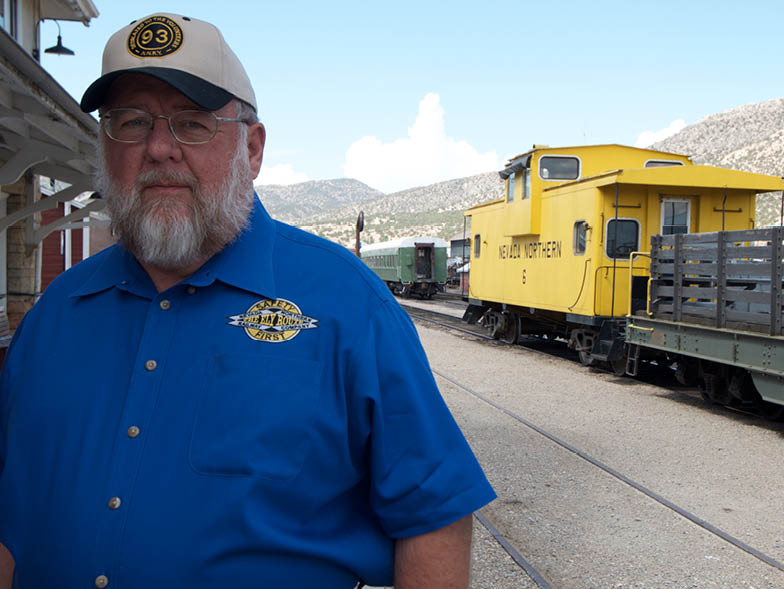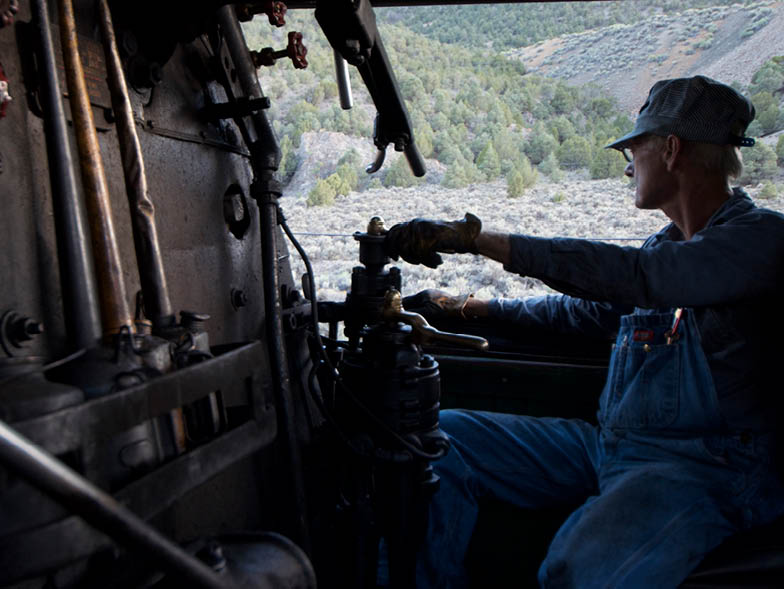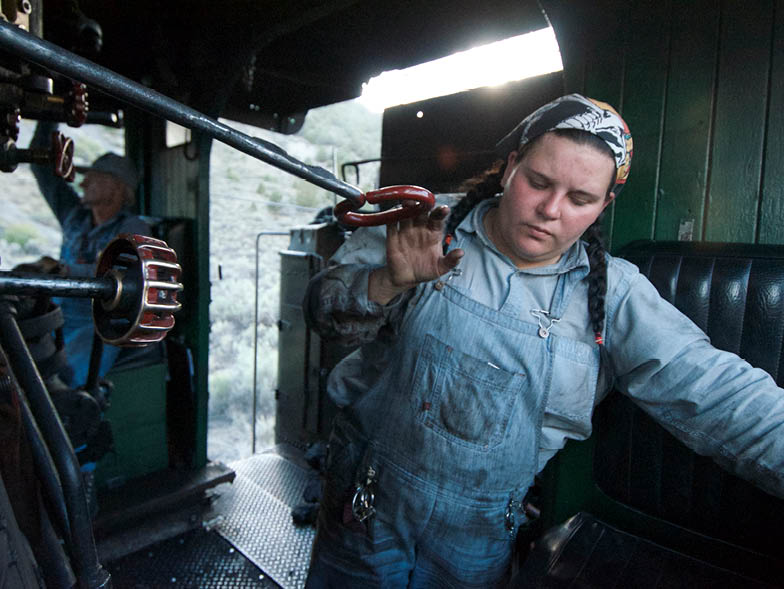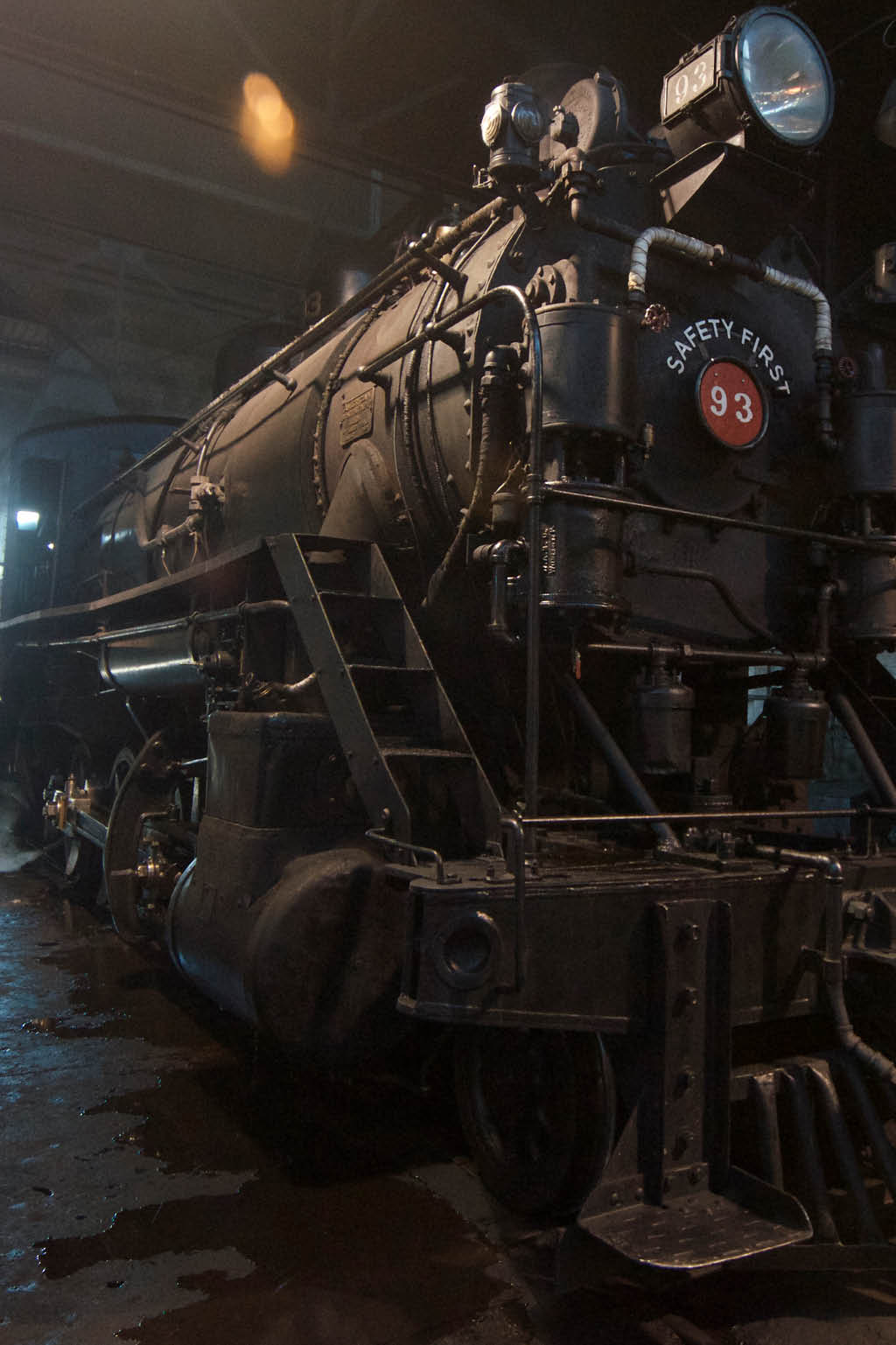All Aboard the Ghost Train!
As you step aboard the old locomotive on a bright summer day here in Ely, Nevada, it’s easy to be smitten. Big, black Engine 93 shines in the sun next to the historical stone depot. Under a brilliant blue desert sky, the steam engine chugs in neutral as the engineer busies himself in the cab and a conductor assists passengers up the steps for this afternoon’s excursion.
Soon, the whistle blows, the big wheels start to turn, black smoke pours out of the stack, and we’re off! But the chance to spend a memorable day riding a historic railroad is a small part of what the Ghost Train is all about. The Nevada Northern Railway, as this place is officially known, is an entire railroad operation run almost exclusively by volunteers.
Walking into the railyard is like stepping into a time capsule from 1938. The Nevada Northern’s engine house, where locomotives were once maintained, stands virtually deserted and quiet, towering over the once bustling railyard. As you step across the silent railroad tracks and into the cavernous building, it’s as if the mechanics, welders, and others who kept the trains running here have just stepped out for lunch, where vintage machinery, cranes, workbenches, and tools fill this airplane-hanger-sized room. There are shelves well stocked with large and heavy nuts, bolts, and a variety of other equipment, along with the socket wrenches, screwdrivers, and assorted tools of the railroad trade. It’s arguably the best-preserved historic railroad in the US.

While it may be eerily quiet here at times, the Nevada Northern is actually alive and well. Its century-old steam engines, Engine 93 and Engine 40, plus a pair of vintage diesels, make regular passenger excursion runs out of the Ely depot during the summer and on special occasions. And a small crew of full-time mechanics still works inside the big engine shop, where they keep the old locomotives operating as good as new. “It’s probably in better shape than when they used it all the time,” says welder Gary North of Engine 40. “It has a lot better oils and lubes.”
When it rolled out of Philadelphia’s Baldwin Locomotive Works in 1910, Engine 40 was the space shuttle of its day. North appreciates the expertise with which it was crafted. “It’s real interesting,” he says of the antique workmanship. “When you tear into them and find out how they built them, their measurements were right on.”
With gold decals that stand out against its black paint, the steam engine has the look of a well-restored classic car. But it takes a lot of work to keep it going. About three hours of maintenance is required for every hour the engine chugs down the track—and not because of its advanced age. “That’s just how it was built,” reveals head mechanic Hank Stewart. “The technology is very primitive compared to today.”
Primitive but still effective—and appreciated by those who work on it today. “It’s enduring technology,” smiles retired United Airlines pilot and train engineer Dale Olsen, as he oils up Engine 93 in preparation for its afternoon run. “It still works very well.”

Olsen is among the many volunteers the Nevada Northern relies upon to keep this so-called “operating museum” up and running. He drives six hours to this remote desert community, located about 250 miles north of Las Vegas, and stays in a hotel to run the train. “Just for the enjoyment of it,” he explains, with a look of satisfaction. “Not everybody gets to do this. I’m old enough to remember the last of the steam trains. I never dreamed that I would even get to ride on a steam engine, let alone be able to run one,” he laughs.
If you’ve ever dreamed of sitting in the driver’s seat of an old-time steam engine, this is the rare place that can make your dream come true. While there is a small paid staff, dozens of volunteers like Olsen do everything it takes to make the trains go, from selling tickets to serving as conductor, brakeman, fireman, and, yes, even engineer. “People who are interested in our heritage and our history can actually come out and volunteer here at the railroad, work their way up, and be one of our steam engineers,” says executive director Mark Bassett.
But becoming an engineer doesn’t happen overnight. “At the minimum,” Bassett clarifies, “We’re looking at a thousand hours.” You can shortcut that process through the Nevada Northern’s Engineer Experience Program. Simply put, if you meet the requirements, you can pay to run the steam engine, the diesel, or both. There are a number of different opportunities, with prices ranging from about $600 to $3,000.
It is an eye-opening experience to sit up front in the engine cab with the engineer and the fireman and see what it takes to run a coal-fired steam engine. It’s hot, hard, dirty, physical work—especially for the fireman, who spends a round trip of just fifteen miles shoveling a ton and a half of coal into the scorching-hot firebox, the blazing furnace that heats the water to create the steam that makes the engine go. It’s essentially a giant boiler on wheels.

Both the engineer and the fireman spend a lot of time before and after the trip lugging around a big, old-fashioned oilcan, lubricating some two hundred oil and grease points on the engine. And when the train is rolling down the track, they have to be on their toes. The crew keeps a sharp eye on gauges, cranking on knobs and blowing the warning whistle, all while making sure the coal fire keeps the water pressure at the right level to keep the train chugging down the track.
It’s a challenge Olsen enjoys. “There’s a science and an art to it,” he explains. “Every trip’s a little bit different.” Angie Cracraft was doing the heavy lifting as the firewoman, shoveling all that coal on the run I took with Dale. One of the few full-time staffers at the railroad, the young woman enjoys her work, concurring with Olsen. “Never the same thing,” she says of her job.
That’s because the staff here wears so many different hats. John Henry McDonnell, who first came to the Nevada Northern as a sixteen-year-old high-school intern, is a good example of this. Just six years later, he can handle almost any job here, and he’s still learning. “I work in the shop. I do track work. I do train service,” the cheerful young man says. “I’m an engineer, a fireman, a brakeman … I’m certified to run both the diesel and steam locomotives.”
It’s fascinating to walk with him through the old buildings around the railyard. The huge structures contain a variety of historic equipment and vintage rail cars. There’s a giant, century-old snowplow to clear the tracks, a mail car, a passenger car dating from the 1870s, and Caboose Number 3. “We bring that out a couple times a year,” McDonnell says of the caboose. “That’s pretty cool, ‘cause there’s old orders from when it was it still running for the railroad.” We climb up into the bright yellow caboose, and he pulls an aging clipboard off a hook that contains a switch list from when this caboose was still running for Northern Nevada.
Tracks were first built in 1905 by railroad pioneer and mine owner Mark Requa to haul ore from what would become the giant Kennecott Copper Mine. During its heyday, thirty-two passenger trains, sixty ore trains, and a couple of freight trains left the Ely Depot—now on the National Register of Historic Places—every day. “Hundreds of people worked here. Thousands of people took the trains. This was the steam-powered Internet of its day,” says Bassett. “Now it’s pretty quiet. We run maybe one train a day. We’re essentially a ghost of our past.” Hence how the steam train came to be known as the Ghost Train.

But the director firmly believes this well-preserved operation, with its complete depot, railyard, shops, tools, and tracks, is much more than just a tourist attraction. “I think the railroad tells the story of America that we’re losing: the story of can-do-ism,” he shares. “Mark Requa had a dream: to build the railroad and develop the copper mine—and he did it! This is what we’re losing as a society. We’re not going out and doing things, building things, conquering things.”
That is not the case inside that big engine house, where McDonnell and his coworkers do what it takes every day to keep the trains running. Just firing up those old steam engines is a major project. It takes four hours to heat up enough water in the engine’s giant boiler to create enough pressure to get those big wheels rolling. But there’s no place this young man would rather be. “I got pretty lucky,” he grins. “There aren’t too many places that run steam locomotives. And there are even fewer that will pay you to do it.”
Without young people like McDonnell and Cracraft, willing to work hard and get their hands dirty, this most unique part of the past wouldn’t have much of a future. “The biggest challenge we have as a museum is that if we don’t pass the knowledge down to the next generation, this stuff won’t run again,” points out Bassett. “We’re teaching our kids that everything is done with the click of a mouse. And that’s not true. Someone has to get their hands dirty. And they have to be taught.”
That mission goes on at the Nevada Northern. The internship program that recruited McDonnell continues to this day. Hopefully, his generation will continue to be intrigued by the old steam engine technology that was cutting edge a century ago and keep the Ghost Train, and all that it represents, chugging down the tracks on bright summer days for years to come.
For more info, visit www.nnry.com.






















